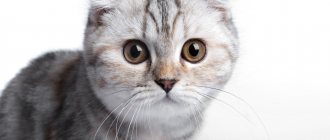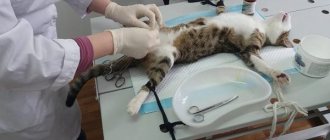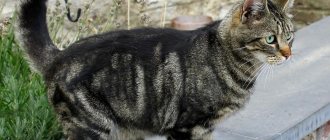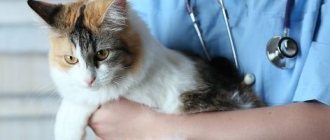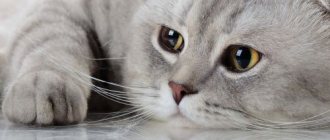If you have recently begun to think about castrating your four-legged pet, we recommend that you take this issue seriously. Neutering your Scottish cat will save you and him from many problems in the future. Seventy percent of animals that did not undergo this procedure suffer from prostate diseases, adenomas of the paranal glands and other diseases.
Hormonal drugs sold in veterinary pharmacies do not solve or completely prevent problems, and sometimes cause side effects.
At what age should you castrate?
It is important for owners of straight-eared and fold-eared Scottish cats to understand when exactly surgical intervention is necessary. If it is done too early, the operation may have a detrimental effect on the pet's development. Carrying it out later often does not rid the Scottish Fold kitten of the habit of marking its territory. Veterinarians from the Zoovet clinic note that it is best to castrate a Scots cat between the ages of 10 and 12 months. At this time, the pet reaches puberty and is fully developed physically, but it still does not have the habit of marking territory and does not have a strong sexual desire. Sterilization of Scottish cats is also carried out at this age.
Early surgery will result in your pet's head being smaller than necessary.
Often, the owner of a straight-eared Scottish cat may encounter an inexperienced veterinarian who has not dealt with purebred pets and is convinced that castration is best done at the age of 6 months. However, experienced veterinarians insist that this should absolutely not be done. If surgery is performed this early, the pet's body will stop developing, causing the head to become too small in relation to the body.
Essence of the operation
Castration is the complete removal of reproductive organs. When castrating cats, their testicles are removed. This operation is simple and is generally tolerated by animals normally. Castrating a cat is more difficult - it requires penetration into the abdominal cavity. There are several methods of surgery, each with its own advantages. We advise you to choose the one that your doctor knows best. Sterilization is the partial removal of reproductive organs, practiced in females, and consists of cutting out the ovaries. The uterus remains. Currently, it is recommended to castrate cats too, since the uterus, being unable to function normally in the absence of ovaries, becomes a target for various diseases.
How is surgery performed?
Despite the fact that the operation is considered simple, it is performed under general anesthesia. With this, it is possible to completely relieve the cat from pain both during and after surgery. First, the pet is given a sedative and then anesthetized. Then the veterinarian proceeds directly to the operation, following the following algorithm of actions:
- Prepares the intervention area.
- Makes incisions on the skin of the scrotum in 2 places.
- Places clamps on the spermatic cords.
- Removes the testicles.
- If necessary, apply stitches.
- Treats the surgical area with an antiseptic solution.
- Administers antibacterial and hemostatic medications.
- Brings your pet out of anesthesia.
- Hands over the Scottish Fold cat to his owners.
For females, the best option for the procedure is to remove the uterus and ovaries at the same time.
If it is necessary to sterilize a cat, it is preferable to remove the ovaries and uterus. This intervention is called ovariohysterectomy. Veterinarians consider this method the most effective for preventing pregnancy. However, there is an easier surgical technique called oophorectomy. During this procedure, only the ovaries are removed.
Preparing a Scottish cat for sterilization
When you register your cat for sterilization, you will be told about the preparations you will need to do at home. Usually, due to the fact that cats are sterilized under anesthesia, you will need to not feed the cat for several hours.
The second stage of preparation is done by a veterinarian in the clinic. This includes an examination, checking the heart, lungs, absence of infections and other health indicators. In some cases, examination and auscultation are enough for doctors to take the cat for surgery, but sometimes doubts arise and additional studies have to be done. If the cat is not young or has suffered from any chronic diseases or has undergone other operations - all this increases the risks, so additional research will most likely have to be done. If the cat is young, healthy and has never had any complaints, it is possible that no additional preparatory studies or tests will be necessary.
Possible risks
In Scottish Fold kittens after castration, the possibility of urethral obstruction cannot be ruled out. Postoperative consequences are also aggravated by an unhealthy pet diet. Excess calcium and phosphorus causes stones in the bladder and kidneys. In addition, fold-eared and straight-eared kittens may experience weight gain after surgery. In order not to increase the risk of various pathologies due to obesity, veterinarians prescribe dietary nutrition to such cats.
General nuances
The most popular methods of castration are vasectomy and surgery. In the first case, the veterinarian will tighten the animal's vas deferens. As a result, it will be sterile, but will still be able to leave marks. In the second case, the pet's testicles will be removed. This will result in him never asking for the cat or marking his territory again.
It is worth considering one more nuance before taking your pet for castration - the animal must be sterilized before its first mating occurs. If it was already there, sex hormones will not stop being produced even after the operation. In this case, the cat will still demand the cat.
Care after castration
While the animal is recovering from the state of anesthesia, you should not put it on the sofa.
Mostly Scottish Fold cats tolerate sterilization well, but some of them may experience pain after recovering from anesthesia. Veterinarians recommend that pet owners place their pet on the floor with a clean sheet on it. It is strictly forbidden to place the animal on a bed or sofa, since after anesthesia the cat can make chaotic movements, as a result of which a fall is possible. Since the cat’s temperature decreases after anesthesia, it will need to be covered with a blanket and a heating pad placed next to it.
The duration of recovery from anesthesia is approximately 6 hours.
Veterinarians draw the attention of owners who have a lop-eared or straight-eared kitten that after castration they should not place a bowl of water next to the pet. This is due to the fact that the animal can lose consciousness, fall face-first into the liquid and suffocate. If we talk about postoperative incisions, the owner will need to treat them daily. A disinfectant prescribed by a veterinarian should be used for these purposes. If your pet begins to scratch the wound, you need to put a special cone-shaped collar on it. To prevent infection from the tray from getting into the wound, the litter for the toilet should be replaced with paper napkins.
Advantages and disadvantages
The following facts will help the owner decide to undergo surgery for his pet.
- As already noted, sterilization and castration of cats significantly reduces the risk of developing serious pathologies of the genitourinary system.
- It has been proven that sterilized cats live longer than those that have given birth. The fact is that during childbirth the animal loses its health and strength, because a cat has to give birth several times a year, and the average life expectancy of Scottish Folds is 10–14 years. Sterilization can prolong a cat's life by 3-4 years.
- The risk of losing your pet is reduced. Now the animal that nature calls outside will not wait near the door for the right moment to escape. This is especially true for residents of upper floors. Often cats, in search of a partner, escape through windows and balconies, and this can be dangerous to their life and health.
- If a partner of a suitable breed is not found for a Scottish Fold pet, then you will have to breed the pet with a representative of unsuitable blood. This leads to offspring that have no value. It will be difficult to sell or give away kittens; outbred kittens often end up on the street. Sterilization will reduce the number of stray animals.
Before enrolling an animal in a veterinary clinic for castration or sterilization, it is worth considering some of the risks that this procedure carries.
- After surgery, animals, especially cats, begin to quickly gain weight due to hormonal reasons. Choosing food for a neutered cat requires a serious approach. To maintain the health of the animal, you have to buy expensive feed.
- During sterilization, the cat is given anesthesia. If the animal has heart problems, it may not tolerate the effects of anesthesia. Therefore, a full medical examination is required before the procedure.
- If an external suture is used during sterilization, the cat should be blanketed for the next few days. The owner needs to ensure that the pet does not get caught in the bandages, remove the blanket or lick the seams.
Features of the life of castrated cats
After the operation, the animal becomes more affectionate.
Pet owners should not worry, since sterilization is an easy and quick surgical procedure, after which undesirable consequences are extremely rare. After surgery, the animal changes literally within a month. The cat becomes affectionate, playful and sociable. The smell of his urine is less pungent, and he stops marking his territory. Sexual desire also disappears.
However, it is important for owners not to forget that after surgery, a Scottish Fold cat may gain weight. In such a situation, diet will help him lose weight. However, it is strictly forbidden to spend days of fasting for a cat and give him only water to drink. Your veterinarian will help you create the right diet, including the required foods that will help you not only lose weight, but also not gain weight in the future. Often, cats are prescribed special complementary foods that can be purchased in stores.
Why is the procedure needed?
Sterilization and castration are carried out to normalize hormonal levels in those pets whose sexual needs cannot be satisfied naturally. There are two types of indications for surgery: medical and behavioral.
An indication for surgery may be the behavior of the animal:
- the cat constantly marks the territory, after which a pungent smell of urine remains;
- the pet is aggressive, rushes at people;
- During estrus, the cat suffers, screams loudly, and cannot find a place for itself.
If it is not possible to regularly satisfy your pet’s sexual needs, then it is better to undergo surgery. After it, the animal will stop suffering from dissatisfaction and will become much calmer and more affectionate. After castration, cats stop marking, and their urine loses its pungent odor.
Medical indications are primarily related to the fact that hormonal imbalances can lead to many diseases in pets:
- Oncological diseases. Cats may develop cancer of the mammary glands, ovaries and other genital organs. In cats, prostate cancer comes to the fore.
- Pathology of the genitourinary system. This category includes urethritis, prostatitis and other inflammatory and infectious diseases. In addition, it has been scientifically proven that this surgical intervention increases the pet’s life expectancy.
- Stop marking the territory;
- Disappearance of the too strong smell of urine;
- Lack of desire to run away from home;
- Stopping aggressive behavior and maintaining a playful nature;
- Increased life expectancy;
- Prevention of prostatitis, prostate tumors, etc.
- Administration of anesthesia (intravenously, often intramuscularly);
- Preparation of the “operation field”;
- Making two or one small incisions in the skin of the scrotum;
- Ligation of the spermatic cords;
- Removal of testes;
- Treating the stump with antiseptics;
- Administration of standard medications (antibiotic, hemostatic).
The operation does not require stitches and is carried out very quickly. The entire procedure will take 15 minutes.
You can choose the option of castration, when the cat sleeps for 3-4 hours (classic option of castration). At the same time, the cat should not eat on this day, and water can be given only 5 hours after the doctor leaves.
There is a more pleasant option of castration, when the cat comes to his senses already in front of the doctor and even goes to accompany the doctor to the doorstep, controlling his body quite well (which is excluded in the classic version). In this option, you are allowed to eat after 2 hours and drink immediately.
If you wish, you can purchase a cat collar from the doctor, which can be worn for the first 2-3 days to prevent the cat from licking the wound.
Immediately after castration, the food does not change, and the cat eats as before, with its usual food. It is recommended to switch to castrated food 3-4 weeks after neutering. When feeding castrated cats, you should follow a special diet that excludes the consumption of fish dishes.
